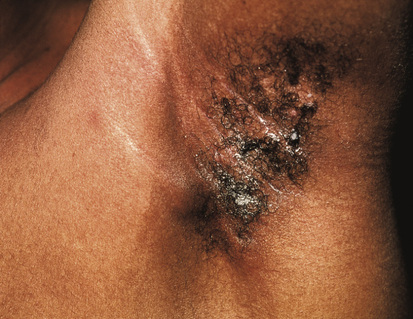Maria Isabel Romano Hidradenitis suppurativa, also referred to as acne inversa or cicatrizing perifolliculitis, has long been considered a disease of the apocrine glands. Histopathologic research indicates that the primary lesion is infundibular hyperkeratosis of sebaceous gland follicles with secondary infection of the apocrine glands.1 The presence of inflamed perifollicular and subepidermal CD3, CD4, CD68, CD79, and CD8 lymphocytes indicates a cell-mediated cause of this disorder.1 This chronic disease is characterized by recurrent abscesses, draining sinus tracts, and comedones and may be found in association with severe nodulocystic acne and pilonidal sinuses.2 The prevalence of hidradenitis is greater in females, with genitofemoral lesions being most common; axillary lesions are found equally in males and females, and anogenital lesions are found more commonly in males.3,4 Case studies indicate that the onset of hidradenitis is associated with the production of adrenal androgens, dehydroepiandrosterone, and androstenedione at the time of adrenarche.2 All ethnic groups are affected. A hereditary predisposition has been noted in females, with mother-daughter transmission being most common, and a familial autosomal dominant tendency exists.2 The exact cause of hidradenitis is not known and is controversial. Theories of causation include keratin plugging of the apocrine ducts and a primary failure of the apocrine glands to drain effectively. An association with immunosuppression is cited in the literature.2,3 With keratin plugging, the apocrine duct and hair follicle are occluded by keratin, which causes increased ductal pressure and inflammation. Bacteria cause the ducts to rupture and, with extension of infection, lead to cyst, sinus tract, and fistula formation. Acne inversa is proposed as a more appropriate name for this disease because in the early stages, the pathogenic change occurs in the pilosebaceous ducts, similar to the pathogenesis of acne.2 Deep cultures of active lesions in hidradenitis suppurativa are often polymicrobial. The most commonly isolated bacteria are Staphylococcus aureus, Staphylococcus epidermidis, and Staphylococcus hominis.5,6 Other organisms implicated include Escherichia coli, Proteus mirabilis, Pseudomonas aeruginosa, and streptococci.6 The hallmarks of hidradenitis suppurativa are single or multiple areas of swelling, pain, and erythema accompanied by acute abscess formation. The active phase of the disease is preceded by the appearance of double or triple black comedones on the affected skin surface (Fig. 56-1). The condition often progresses to a chronic state of pain, sepsis, sinus tract and fistula formation, purulent discharge, and keloids. Disfiguring scar formation marks long-standing hidradenitis. Patients usually give a history of multiple episodes of repeated abscesses that have been drained and treated with antibiotic medications for a period of years. Unlike acne, the disease is unrelenting and often progressive, leaving hypertrophic scars that form a basket-weave configuration accented by marked erythema beneath the breast and in the axillary, suprapubic, groin, and anogenital regions. Sinus tracts form under the skin in which connecting, inflamed, and plugged glands drain into one another and trap bacteria. Patients are concerned about the cause of the problem and may fear they have a malignant disease. Predisposing factors include obesity, dissecting cellulitis of the scalp, smoking, hirsutism, history of acne, use of lithium, and hyperandrogenism.3,5 Remissions of a spontaneous nature are noted in patients older than 35 years.6 The lesions are palpated to determine their readiness for incision and drainage. The axillae, groin, perianal region, buttocks, chest, inframammary area, and back are examined to determine the involvement and extent of the disease. Hurley stages are used to classify the severity of the disease (Box 56-1).2,3
Hidradenitis Suppurativa (Acne Inversa)
Definition and Epidemiology
Pathophysiology
Clinical Presentation
Physical Examination
Hidradenitis Suppurativa (Acne Inversa)
Chapter 56







